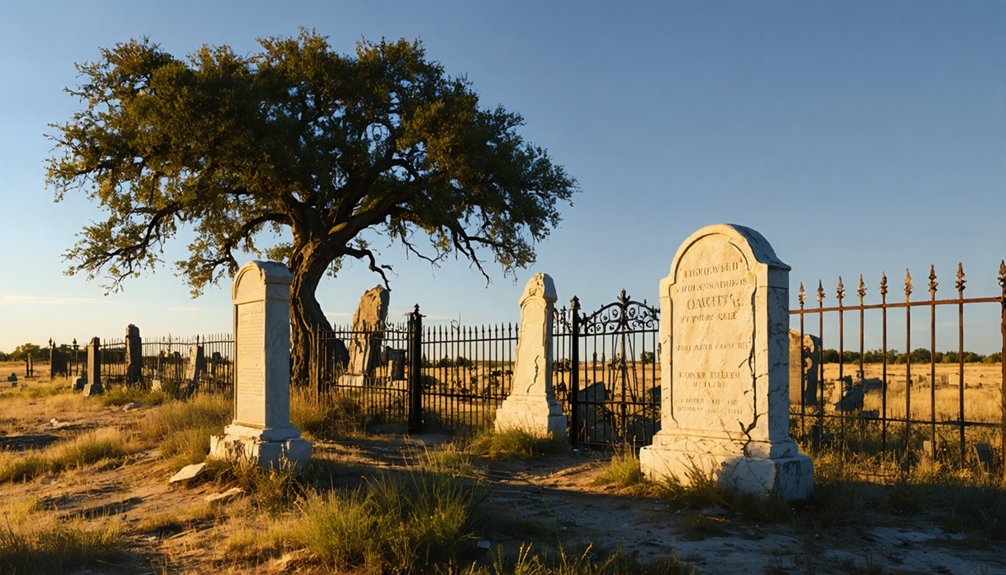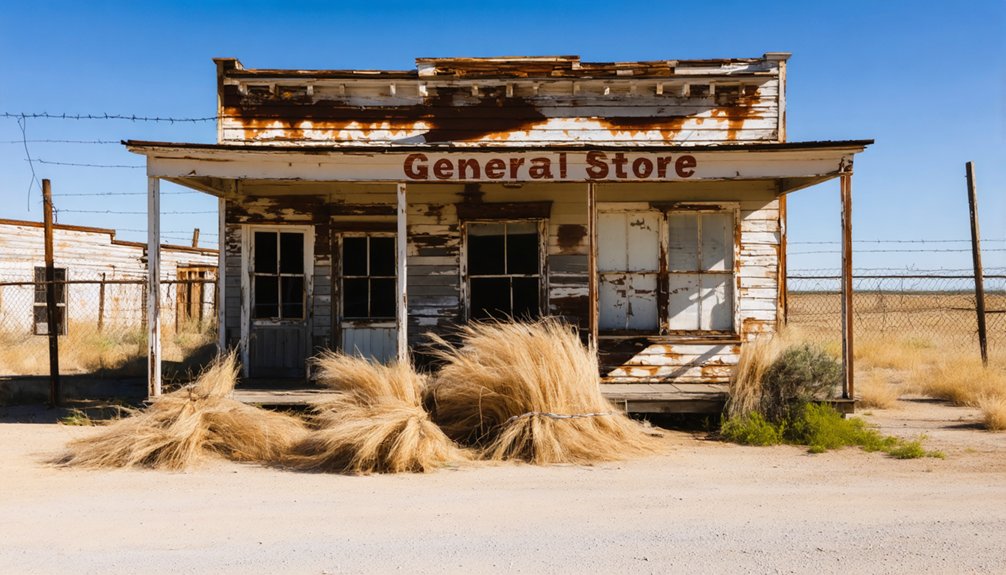You’ll find Kirkland, Texas as a fascinating ghost town that evolved from an 1880s stagecoach stop into a bustling railway community. After relocating to embrace the Fort Worth & Denver Railway’s arrival, the town flourished with saloons, mercantile stores, and livestock shipping facilities, reaching 500 residents by the 1920s. Today, you’ll discover deteriorating buildings, a historic cemetery dating to 1908, and traces of pioneer life slowly returning to the Texas grassland.
Key Takeaways
- Kirkland transformed from a bustling stagecoach station to a ghost town after reaching its peak population of 500 residents in the 1920s.
- The town relocated near the Fort Worth & Denver Railway tracks in the late 19th century to maintain economic viability.
- By 1980, Kirkland’s population dropped to around 100 residents, with only two churches and one store remaining operational.
- The historic cemetery, established in 1908, remains a preserved landmark documenting the community’s pioneer heritage through well-marked graves.
- Original town structures are now deteriorating, with visible traces of former buildings, pecan orchards, and the historic Furr’s Groceries mercantile building.
The Railroad’s Arrival and Town Relocation
When the Fort Worth & Denver Railway arrived in Hardeman County during the late 19th century, it catalyzed a pivotal transformation for the original Kirkland settlement.
The arrival of Fort Worth & Denver Railway transformed Kirkland’s destiny, marking a turning point for this frontier settlement.
You’ll find it fascinating that the railroad’s impact forced the entire town to physically relocate from its original stagecoach stop location. Rather than face economic isolation, the townspeople made the bold decision to move their businesses, homes, and community infrastructure to a new site adjacent to the railway tracks.
This strategic town relocation proved momentous, as you’d expect from such a dramatic change. The move positioned Kirkland for incredible growth, leading to the establishment of two bustling saloons. Similar to the Elmina & Eastern railroad that operated in Walker County, the railway system became crucial for local transportation and commerce.
Kirkland’s new position along the Fort Worth & Denver line opened up crucial transportation and trade routes, transforming the former stage stop into a growing town with enhanced prospects for commerce, population growth, and regional connectivity.
Rise of a Frontier Trading Post
Before becoming a major railroad town, you’ll find that Kirkland’s origins were rooted in its role as a bustling stagecoach station along the route from Wichita Falls to Mobeetie in the early 1880s.
The original settlement, situated seven miles northeast of its current location, featured two saloons, an inn for weary travelers, and a general store that served both residents and those passing through.
You can trace the town’s early economic foundation to its function as a crucial relay station, where the presence of essential services and businesses marked the beginning of what would become a significant frontier trading post. The town was named after pioneering settler J. C. Kirkland, who helped establish the community.
The Kirkland Mercantile Co. became one of the town’s most prominent businesses, serving as a vital commercial hub for the growing community.
Early Stagecoach Station Days
During the mid-1800s, Kirkland emerged as an essential frontier trading post along Texas’s expanding stagecoach network, serving as a strategic relay point for mail delivery and passenger transport. You’d find the station positioned approximately 20 miles from neighboring stops, perfectly situated to provide fresh horses and rest for weary drivers traversing the rugged frontier.
As part of the Butterfield Overland Mail’s expansion in 1858, Kirkland’s significance grew as stagecoach routes connected San Antonio to El Paso and New Mexico. Travelers paid a dime per mile for their journey through the frontier outpost. The station was part of a system where exact schedules were mandated for departure and arrival times by mail contracts.
While you might’ve encountered dangers from Indian raids and property theft, the station persisted, offering vital services like mail handling, coach repairs, and trading supplies.
Local settlers and travelers alike depended on Kirkland’s strategic location, making it a critical hub for news exchange and frontier commerce.
Railroad Brings Town Growth
Upon the Fort Worth and Denver City Railway’s arrival in 1887, Kirkland’s destiny changed dramatically as residents relocated their entire community to align with the new rail line in Childress County.
You’ll find that the railroad benefits transformed this former stagecoach stop into a bustling frontier trading post, with John Quincy Adams platting the new townsite on his homestead land.
The economic transformation was swift and substantial. By 1890, you’d have seen a thriving mercantile store, post office, and cattle shipping pens. Like the early Athens railroad initiatives, this period saw the post-Civil War depression heavily impact the region’s development.
Despite the Panic of 1893‘s brief setback, Kirkland flourished with multiple grocery stores, lumber yards, and hardware stores by the 1920s, similar to towns along the Texas and Pacific Railway which experienced growth through land grants.
The railroad enabled efficient shipping of wheat, livestock, and timber, connecting local farmers and ranchers to broader markets and securing Kirkland’s position as an essential commercial hub.
The Legacy of Furr’s Store
As Kirkland, Texas emerged in the early 1900s, Crone W. Furr established the Kirkland Mercantile Company, planting the seeds for what would become a regional retail empire.
Furr’s legacy began with a simple store but quickly evolved into a pioneering force in grocery evolution across West Texas and New Mexico. Roy Furr utilized his experience from teaching until 1923 before joining the family business. The company later expanded to operate 92 family-style cafeterias across eleven states.
From humble beginnings, Furr’s transformed into an innovative retail pioneer that shaped how people shopped and dined across two states.
- A devastating 1915 fire led to rebuilding with three sturdy brick structures.
- The mercantile store transformed into Furr Food Stores through M System franchising.
- Roy Furr innovated by combining groceries with cafeterias in 1947.
- The business expanded to 140 stores by 1978.
- German investors acquired the company in 1979, separating grocery and cafeteria operations.
You can trace the remarkable journey from a single Kirkland storefront to a multi-state operation that revolutionized regional retail and dining experiences throughout the 20th century.
A Community’s Peak and Decline
While Furr’s retail empire expanded beyond its humble Kirkland origins, the town itself experienced its own remarkable story of growth and change.
You’d have found a bustling community at its peak in the 1920s and 1930s, where three churches, multiple grocery stores, and five filling stations served a population of 500 residents. The town’s community resilience shone through its role as a crucial agricultural shipping point.
But economic shifts began reshaping Kirkland’s destiny after 1940. You would’ve witnessed how modern farming reduced labor needs, while improved roads drew residents to larger cities.
The 1958 school consolidation with Childress marked a turning point. By 1980, only two churches and one store remained, as the population dwindled to around 100 – a shadow of its former vitality.
Cemetery: Hallowed Ground of Pioneers

The hallowed grounds of Kirkland Cemetery, established away from the original townsite in keeping with pioneer planning practices, tell a story that begins with its first documented burial on March 1, 1908.
You’ll find this sacred space preserving the pioneer heritage of early settlers through carefully maintained gravesites and iron-fenced family plots.
When you visit this historic cemetery, you’ll encounter:
- Weathered tombstones revealing lifespans of farmers and merchants
- Iron fencing enclosing notable family plots
- Grid-like layout mirroring the original town’s planned structure
- Well-marked graves documenting early resident histories
- Rural surroundings that maintain the site’s solemn character
Cemetery preservation efforts continue despite Kirkland’s ghost town status, protecting these physical connections to the community’s past for future generations seeking to understand their pioneer roots.
What Remains Today: A Ghost Town’s Footprint
Moving beyond the cemetery’s preserved memories, Kirkland’s physical remnants paint a picture of pioneer life frozen in time.
You’ll find the original town sign standing sentinel over deteriorating buildings, many now roofless and slowly returning to the earth. The old stagecoach and railroad routes that once brought life to this settlement are still traceable, though nature steadily reclaims them.
Historical markers dot the landscape, telling stories of what once was, while the town’s original layout remains visible in the streets and building foundations.
If you look carefully, you’ll spot traces of former pecan orchards and ranching operations among the grassland and scrub. The Furr’s Groceries mercantile building, though dilapidated, stands as a symbol of Kirkland’s bygone economic significance.
Frequently Asked Questions
Are There Any Paranormal Activities Reported in Abandoned Buildings of Kirkland?
You’ll find reported ghost sightings at the abandoned Ranchotel and schoolhouse, though they’re unconfirmed. Local legends tell of unexplained voices, shadow figures, and cold spots in these haunted locations.
What Was the Average Cost of Living in Kirkland During Its Peak?
You’d find that while specific historical records don’t document average expenses, Kirkland’s peak-era living costs were typical of small rural Texas towns, with affordable housing and locally-sourced goods keeping daily expenses relatively low.
Did Any Notable Outlaws or Criminals Pass Through Kirkland?
You won’t find any famous outlaws or criminal legends connected to Kirkland in historical records. While Texas had its share of gunslingers, there’s no evidence they frequented this stage line stop.
What Natural Disasters or Severe Weather Events Impacted Kirkland’s History?
Like a thirsty land yearning for rain, you’ll find Kirkland was shaped by recurring drought effects and severe storms. While flooding impacts weren’t documented specifically, the semi-arid climate challenged the town’s survival.
Were There Any Native American Settlements in the Area Before Kirkland?
You’ll find that Plains tribes like Comanche, Kiowa, and Apache historically roamed this area, though there’s no evidence of permanent Native American settlements directly at Kirkland’s future location.
References
- https://brainly.infogalactic.com/info/Kirkland
- https://en.wikipedia.org/wiki/Kirkland
- https://en.wikipedia.org/wiki/List_of_ghost_towns_in_Texas
- https://worldofdecay.blogspot.com/search/label/Kirkland
- https://mix941kmxj.com/what-makes-this-the-most-famous-ghost-town-in-texas/
- https://www.texasescapes.com/TexasPanhandleTowns/Kirkland-Texas.htm
- https://www.allacrosstexas.com/texas-ghost-town.php?city=Kirkland
- https://mix941kmxj.com/from-the-biggest-little-city-in-texas-to-ghost-town-kirklands-tragedy/
- https://ttarchive.com/Library/Articles/Elmina-Ghost-Town-Walker-County_Oliphint.html
- https://mix941kmxj.com/a-weird-texas-ghost-town-that-never-technically-got-its-start/



